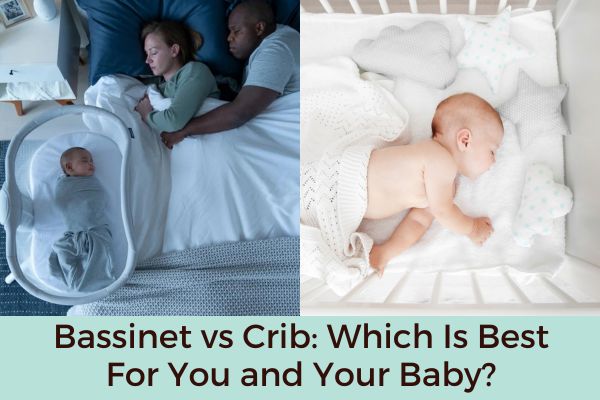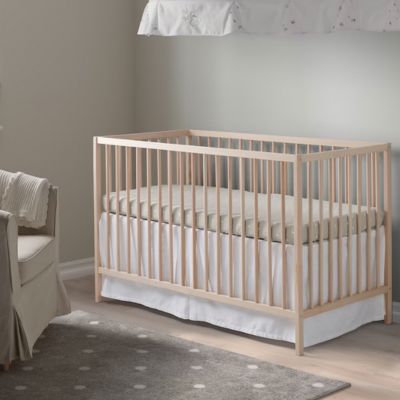It can be hard to decide between a bassinet vs crib, especially if you’re having your first baby.
Will it be fine to get a co-sleeper bassinet so your baby can sleep safely right next to you?
Or would it be better in the long run if they’re used to sleeping in a crib?
Will it be a waste of money to get a bassinet just to transition them to a crib?
What if your baby hates the crib??
Relax, breathe, and let’s list down first the pros, and cons of a crib vs bassinet.
Then we’ll consider your priorities, the challenges of a bassinet, and what other alternatives are out there if you want to explore more.
Let’s get going.
I hope you’ll love the products we recommend! Just a quick note: if you click on a product link below and decide to buy it, we may earn a small commission.
List of Contents
Crib
Cribs are larger than bassinets, providing enough if not more room for babies to move in.
Most, if not all, comes with adjustable mattress heights, accommodating your child’s growth.
They may require more space but they are a long-term investment, as they can be used from infancy to toddlerhood.
If you can get a convertible crib, you can even use them until your child is much, much older!
Unless your kid tries to climb out of their crib of course like mine, but that’s another story.
Benefits of a Crib:
- Enough sleeping space for your baby, even for a toddler
- Can be used for years, especially if it’s a convertible crib
- Can be used for travel, if it’s a travel crib, like the Guava Lotus
- Can get one with a bassinet conversion, like the Babyletto Yuzu
- Has an adjustable mattress height to accommodate your child’s growth
- Promotes independent sleep for babies
- Keeps your baby safe, especially when you need to run to the bathroom or the door
- You can have your bed as the baby has his/her crib!
Cons of a Crib:
- Takes up space
- Heavy and most are easy to move around from room to room
- Not travel-friendly or portable
- Minor issue but some babies can have their legs get stuck between the crib slats
- Minor issue but your baby can chew on the crib
Bassinet
Smaller and more portable than cribs, bassinets offer a snug and comforting environment for your baby’s early weeks.
Their compact size is perfect for keeping your baby close by, especially during the night.
They can only be used for a few months but they can be a convenient option for families with limited space.
Portability and easy access make bassinets a popular choice for parents seeking a temporary sleep solution for their little one’s first months.
Benefits of a Bassinet:
- Creates a cozy, womb-like environment that can help babies sleep longer and better.
- Provides easier access to baby at night, especially if you’re breastfeeding and/or had a c-section
- Saves space in the bedroom
- Lightweight and portable, easy to move around the house
- Most can be travel-friendly and easy to carry in the car or on a plane, like the bassinet/ crib below:

Cons of a Bassinet:
- Babies can quickly outgrow bassinets, making it dangerous for them to stay on it longer
- Can only use it for less than 6 months
- Investing in both a bassinet and a crib can be expensive
- Transitioning a baby from a bassinet to a crib might be challenging
Factors To Consider When Choosing Between Bassinet vs Crib
Consider the following aspects to make an informed choice between a crib and a bassinet:
Age and Weight of Baby
Bassinets are designed for newborns and younger babies, offering a snug and secure space during their early weeks.
Cribs, on the other hand, can be used from newborn until toddlerhood, providing enough room they need to move around and grow.
Consider your baby’s current age and weight to determine which option aligns with their developmental stage.
Space
Evaluate the available space in your home when deciding between a bassinet and a crib.
Bassinets are smaller and more portable than cribs, making them a practical choice for families with limited room. If you’re planning to keep your baby close by in your bedroom, a bassinet’s compact size might be a better fit.
Cribs, while spacious, require more floor space and might be better suited for dedicated nurseries.
Budget
Your budget also plays a significant role in this decision.
Bassinets are often more budget-friendly compared to cribs. If you’re looking for a temporary sleep solution or have financial constraints, a bassinet could be the cost-effective option.
On the other hand, cribs are a more substantial investment, offering a long-term sleep solution that can span several years.
They can be expensive but you can also find affordable cribs if budget is a concern.
Convenient and Functionality
Convertible cribs come with added functionality and can adapt to your child as they grow.
So consider if you want a piece of furniture that can be converted and used for years to come or just a simple, straightforward sleep space.
On the other hand, co-sleeper bassinets can provide easier access to your baby, allowing you to tend to them without having to get up from your bed.
Most are also portable and travel-friendly, which is convenient for trips and vacations.
Longevity
Cribs can be used longer than a bassinet, saving you the hassle and cost of needing to replace the latter after just a few months.
Provided that your baby doesn’t start climbing soon out of their crib, that is!
Safety Considerations
Both bassinets and cribs must adhere to strict safety standards, ensuring a firm, flat sleeping surface and no loose bedding or pillows that could pose suffocation hazards.
Check if your chosen option is at least JPMA certified, so you’ll at least know that it’s safe for your little one.
Ensure that your chosen option meets safety guidelines to provide a secure sleep environment for your little one.
Transitioning Baby From Bassinet To Crib
It can be challenging to transition your baby from their bassinet to their crib but do they try out these tips first to guide you through the process:
- Make them nap in the daytime in the crib first for a few weeks, before transitioning to a nighttime sleep.
- Place your baby’s favorite toys or items in the crib.
- Create positive associations with the crib by being playful and spending happy moments there during the day.
- Stay consistent and resist the urge to change up any routine.
- Sit next to the crib if your baby is having a hard time adjusting to it. Then just gradually move farther away so your little one can get used to their new sleeping environment.
- Don’t take them out of the crib immediately when they start crying. Just try patting, shushing, or offering a pacifier first.
- Be patient and understanding as your baby adapts to the new sleep environment. Some nights might be smoother than others, and that’s perfectly normal.
Bassinet and Crib Safety Tips
They may be different but cribs and bassinets have more or less the same safety standards, especially when it comes to containing your little one:
- Choose one that has safety certifications
- Ensure that it’s sturdy and stable
- Ensure the mattress is firm and fits snugly against all sides
- No loose bedding, pillows, stuffed animals and other items in crib or bassinet
- Always place your baby on their backs
- Make sure the bassinet or crib is placed away from cords, blinds, curtains, or any potential choking or entanglement hazards.
- If your baby is starting to roll or is trying to sit up, don’t use the bassinet anymore.
- If your baby is attempting to get out of their crib, it’s time to transition them to a floor bed or a toddler bed.
Best Bassinets for Newborns
If you’re leaning toward a bassinet, here are some top options to consider:
You can check out more of the best bassinets for newborns here.
Best Cribs for Babies
For those considering cribs, check out these highly-rated options:
Check out more of the best baby cribs for newborns and toddlers here.
Alternatives to Cribs and Bassinets
Apart from traditional cribs and bassinets, you can explore alternatives such as:
Cradles: They can be used like a rocking bassinet but again, they can only be used for a few months.
Pack n plays: They don’t take up space as a crib and can be used longer than a bassinet!
Travel cribs: They are more or less the same as pack-n-plays, except that they are lighter and easier to carry around for travel.
Floor beds: They can promote independent sleep but it can be challenging to make a very active toddler sleep on it initially!
FAQ About Cribs vs Bassinets
Which is better: crib or bassinet?
Which is better would depend on your priorities, space, budget, and your baby’s age.
Do I need both a bassinet and a crib?
No, you don’t need both a bassinet and a crib.
But it’s not a bad idea either to get both.
Just choose one based on your budget and priorities first.
How long does a baby usually stay in a bassinet?
Babies usually stay in a bassinet for a few months, so they can easily outgrow a bassinet within less than 6 months.
When should you not use a bassinet?
You should not use a bassinet if your baby exceeds the weight or age limit specified by the manufacturer.
Can I use a second-hand bassinet or crib for my baby?
Yes, you can use a second-hand bassinet or crib for your baby but just make sure that you’ve thoroughly checked it, it has not been recalled and it meets current safety standards.
Bassinet vs Crib: Wrapping Up
In this delightful dilemma of bassinet vs crib, there’s no one-size-fits-all answer.
Your choice will depend on your space, lifestyle, budget, and your baby’s needs.
I recommend considering first your budget, then your space, your lifestyle, and so on.
I hope this article has helped you make the right choice for your baby!
If you like this guide, then make sure to check out What To Do If Baby Hates The Crib, How To Get A Newborn To Sleep In A Bassinet, and How to Make Bassinet More Comfortable So Your Baby Can Sleep.







